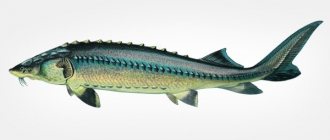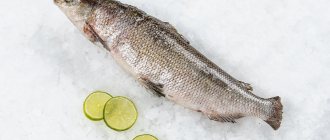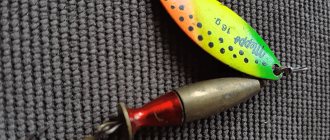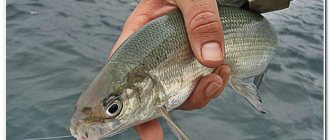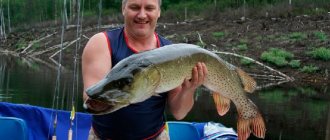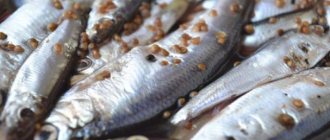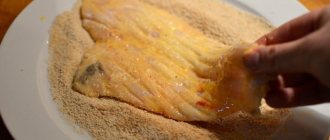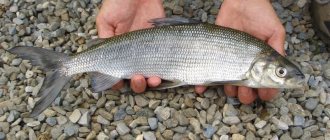There are many salmon fish, one of the families is whitefish, a numerous, little-studied fish genus with variable characteristics. Representatives of this family have a laterally compressed body and a small mouth for their size, which causes a lot of inconvenience for fans of fishing with a rod. The lip of a whitefish often cannot withstand the load when it is pulled out of the water, and when the lip breaks off, the fish leaves.
Due to the similarity of the silhouette of the whitefish’s head with the head of a herring, whitefish are also called herring , and only the adipose fin clearly indicates their salmon origin. The extremely high degree of variability of characters still does not allow us to establish the exact number of their species: in each lake it is possible to establish its own special species, for example, 43 forms were identified in the lakes of the Kola Peninsula alone. Currently, work is underway to combine similar forms into one species, which should lead to the systematization of fish species of the whitefish family.
Total information
To begin with, it is worth saying that this family includes about fifty species of fish. Some are more famous and widespread, while others are less so. Some reach a weight of several hundred grams at best, while others grow up to 10 kilograms.
Of course, despite certain similarities in appearance, the fish are quite different. But all whitefish species have a long body, slightly compressed at the sides. Not too large head, on which large eyes stand out, as well as a small mouth. The back often shimmers in a number of shades - green, gray, bluish, while on the sides the body is usually silver.
Also, all whitefish breeds have an adipose fin - between the dorsal and caudal. There are no muscles connected to it, and it does not affect the streamlining of the fish’s body. Therefore, experts have been wrestling with the question of why it is needed at all for several years now, but have not yet come to a common conclusion.
The meat has excellent taste, and its high fat content makes it an important element in the cuisine of many northern peoples. Moreover, it was thanks to him that many peoples of the north managed to survive in harsh climatic conditions. Although whitefish are related to salmon, their meat is not red, but white, and in some cases, pinkish in color.
Of course, listing all the representatives of such a large family would be very problematic. Therefore, we will make a short list of whitefish species. Let's include here the most famous and widespread representatives of the breed:
- peled,
- vendace,
- muksun,
- tugun,
- Amur whitefish,
- Baikal omul,
- Pyzhyan,
- chir.
Yes, all these fish, although not too similar to each other, belong to the same family. Where do they live? Let's try to sort this issue out.
Whitefish family
The fish family itself can include more than forty different species of fish.
The most popular among them is whitefish. The species includes a list of forms that are often regarded as independent species. For example, this is Valaamka, sand, Neva, river and even sea whitefish. These inhabitants of the aquatic world can be found in the reservoirs of North America, Europe and Asia. The largest specimens were found in North American countries, reaching almost ten kilograms.
general information
The fish is distinguished by a long, laterally compressed body, a small head with especially large eyes compared to its background, and a small mouth. The side of the predator is silver in color, and the back simultaneously shimmers with blue, green and gray shades.
If we are talking about the size of an individual individual, then this is still a large specimen. Although the weight varies solely depending on its type. For example, the lake species of this family can reach a weight of more than ten kilograms. Trophy meat has excellent taste and belongs to the traditional cuisine of the northerners.
Distribution and habitats
The predator prefers only running, cold and clean water. Small fish prefer to be found in the coastal zone, near steep rivers, including in channels. Larger individuals choose as their habitat an area closer to the fairway, under rifts, in deep holes, as well as places bordering fast and slow currents. The fish can only get along with grayling and perch.
But this is the case if their habitats, or rather horizons, do not intersect. But in general, our individual will completely exterminate all other inhabitants of the aquatic world that decided to occupy its territory.
Lifestyle
Depending on their size, the inhabitants of the aquatic world differ in their way of life. Small specimens adhere to the coastal zone year-round. While trophy individuals choose deep holes, including riffles with a fast stream. In the morning and evening, big whitefish can also visit the coastal waters. An interesting fact is that the fish most often waits for its prey from the hole.
Fish feeding occurs throughout the year, and winter is no exception. Bottom organisms act as the main food, since whitefish cannot filter plankton on their own.
Adults can also feed on other types of fish. Observations have shown that the predator also feeds on caviar, including that of its relatives.
Sexual maturity of an aquatic inhabitant occurs after three years of age. The predator prefers to lay its eggs on the fairway of a river reservoir. Spawning occurs in September and lasts until December. Moreover, the laying of eggs by females does not occur.
With the arrival of cold weather, the predator finds warmer places. These may be their previously favored deep holes and ditches. At the same time, whitefish caviar will lie like this all winter. And only with the melting of the snow will the fry begin to appear, who were really looking forward to the warmth and the formation of a large amount of food.
Habitat
Now let’s write where these fish live.
It turns out – in almost the entire Northern Hemisphere! Some species can be found in the USA, almost all European countries and, of course, in Russia. You can see whitefish in many large bodies of water, from the Kamchatka Peninsula in the east to the Kola Peninsula in the west.
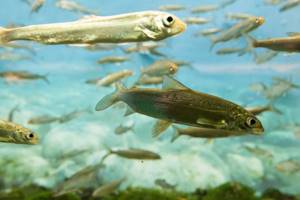
Moreover, they inhabit only reservoirs with cold and crystal clear water. The high activity of fish means that it needs a lot of oxygen. Therefore, most often they can be seen in rivers with fairly strong currents, riffles and even small waterfalls - here the water is most saturated with air. In lakes, whitefish species, the list of which is given above, prefer to stay near places where rivers and streams flow into a larger body of water, enriching the water with oxygen.
Juveniles usually stay in the coastal zone, preferring areas with snags and low-hanging branches of trees and shrubs. On the one hand, here you can hide from larger predators. On the other hand, in such places you can always find larvae and various insects, which constitute the main diet of fish at an early stage of development. But adult specimens prefer to live on the river fairway, often choosing riffles with deep holes and the border of areas with slow and fast currents.
Among the fish of the family there are both freshwater ones and those that prefer salty sea water. However, there are also anadromous ones (for example, Siberian vendace and omul), which feel equally comfortable in both fresh and salt water, spending part of their time in the seas and rising to spawn in fresh streams and rivers.
Features of whitefish fishing

The hunt for a trophy should begin immediately after the snow melts. It is recommended to use jigs as bait, modernized and modified for specific fishing conditions. So, grayling spawns in May. And our fish is just eager to feast on caviar. That is why at this time it is worth giving preference to those tackles that are somewhat similar to caviar.
From early to mid-summer, mosquitoes actively dominate water bodies. Therefore, equipment that imitates this insect will be in definite demand among predators. From mid-July and right up to September, the individual becomes very passive to various kinds of baits. Because there is already a lot of food in the reservoir.
Already with the arrival of cold weather, when the fish need to actively feed before spawning, the bite resumes. In the coastal zone you may come across small specimens. If you decide to hunt for a real trophy, then you should go to the fairway.
The whitefish bite is particularly sharp. The attack of the bait occurs instantly, rising diagonally to the top. Then the fish makes a sideways turn, and the prey is attacked and quickly goes to depth. If a predator, having grabbed the bait, is in one place, this is the exception rather than the rule.
In the process of fishing, prepare for the most powerful resistance of the individual. If fishing takes place from a boat, he dives under its bottom, and unfortunately everything ends with the fish disappearing. And near the coast, a whitefish can turn belly up and dive. As a result, the hook flies out of his mouth. This is a very cunning prey, which is not so easy to catch.
Fishing for whitefish with a float rod
Even taking into account the fact that whitefish is a predator, it can be caught using a standard float rod. This type of fishing gear is recommended for use in the spring, when everyone uses worms as bait. In this case, it is not intended to use anything special.
A standard telescopic rod of five meters, a monofilament thread that can support a large specimen - and you can safely go fishing. Some fishermen choose 0.2 mm thick braid. It is recommended to take a float that is not very large.
Plus, the color of its lower part should be a neutral shade. All in order not to scare off the cautious predator in any way. The number of hook used will depend entirely on the size of the bait, including the weight of the expected catch.
Fly fishing for whitefish
Fly fishing for trophies is possible both in summer and winter. As equipment, you can choose a fishing rod 0.6 m long and a reel with a movable spool. The most important tackle in this case is a pear-shaped sinker weighing up to 15 grams. It is placed at the tip of the leash. A couple of nymphs are placed slightly higher, at a distance of 0.3 meters from the sinker. To do this, you can also select homemade products that imitate larvae, for example, from red yarn.
It is recommended to lower the tackle created in this way to the surface of the bottom of the reservoir, and then slightly lift it. If you don't have a fish finder with you, finding whitefish habitat will be an insurmountable task. But if you are lucky enough to catch at least one predator, be sure to mark the depth of its location on the braided line, and search precisely in this horizon.
Fishing for whitefish with a spinning rod
Hunting for a trophy using a spinning rod using the jig method is considered the most exciting and interesting. The most difficult thing in this case is finding the location of the whitefish. The equipment is not much different from pike perch jigs. A spinning rod with good sensitivity, braid and a reliable reel are all you need. As for the choice of jig baits, there are no restrictions.
You can take any model, the main thing is that they are suitable in size. Whitefish has a narrow throat, like pike perch, which is why it is important not to overdo it when choosing baits and hooks.
For this type of fishing, light shades of bait are well suited. You can also take bright yellow, orange and even acid yellow bait models. They will definitely not go unnoticed by the predator.
Bottom fishing for whitefish
This type of fishing for specimens of the whitefish family is recommended to be used in late autumn. It is at this time that the predator often approaches the coast. In this case, it is necessary to prepare a bottom with a reel that has fast reeling, a monofilament thread that can withstand a future catch, and a sinker.
Experienced fishermen recommend using maggots as the main bait. It is worth throwing the bait into the reservoir so that it reaches the surface of the bottom of the reservoir. And only then can you begin to implement bottom wiring. Produce it slowly and evenly, with short pauses. Only in this case will the bait have the necessary attractiveness for whitefish.
Bottom fishing can be done in a slightly different way. At the same time, a sinker located on a monofilament thread and an artificial red bait catch the surface of the bottom of the reservoir and, of course, the pit. Since these are the places the predator often chooses to live.
Tactics and methods of catching whitefish in winter

In the winter season, you should give preference to a nodding fishing rod, which is particularly durable and frost-resistant. It is created on the basis of a reliable wooden rod with a length of 0.3-0.4 m. The equipment can be used without a nod. And they are not equipped with coils at all. The fishing rod body, which is created in the form of a reel, acts as a storage area for fishing rods. It is recommended to take a particularly high-quality fishing line; if it is a monofilament thread, then at least 0.17 mm thick.
A fishing rod for implementing the vertical trolling method is the most popular method of fishing for a predator. If you equip this equipment with high-quality bait, your catch will be large. The spinner game is standard. This is an alternation of twitches and short pauses.
Particularly reliable balancers for fishing predators - beyond any competition. Although today fishermen often use homemade ones. For example, a jig or an artificial fly. The latter are fixed slightly above the spinner.
Lures, baits, lures, groundbait
It is recommended to use a variety of invertebrate models as bait, including artificial imitation eggs and fry.
If you plan to bottom fish and hunt with a wire fishing rod, you should give preference to worms, shellfish meat and invertebrate inhabitants of the aquatic environment.
The predator reacts well to fly baits with light “petals” and to large jigs. As in the process of fishing for perch, the additional use of a fish eye jig has an amazing result.
Whitefish is a very popular and tasty fish that is especially popular today. But to catch a predator you should try, because it is very difficult to find it in the thickness of the reservoir.
Fish habits
It’s worth saying right away that although many representatives of the whitefish family are similar to carp (for example, roach, dace and others), they are predatory. Moreover, they feed throughout the year, remaining active even in winter, when many other fish become more lethargic and lose their appetite.
The whitefish diet includes juveniles of various fish species. They also enjoy caviar, including the caviar of their own brothers.
In the wild, they get along well with perch and grayling, especially since they inhabit different water horizons. But as soon as the neighbors enter the territory of the whitefish, the latter immediately show aggression, expelling the uninvited strangers.
Reproduction
They become sexually mature at the age of three years - some at four or five years. After this, the fish go to spawn, often rising to the sources of rivers and streams, covering a long distance in a matter of days. Spawns mainly in the river fairway, choosing places with weak currents. Different whitefish breed in different months - from early autumn to early winter. The males fertilize the eggs, after which the adult fish slide downstream or find deep holes that will not freeze even on the coldest winter days.
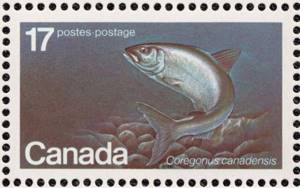
The eggs take quite a long time to develop - the larvae hatch only in the spring, after the first snow has melted. By this time the water has warmed up sufficiently, and there is especially plenty of food in the river, which ensures a high survival rate.
Now let's talk in more detail about the different whitefish from the list above.
Features of reproduction
Due to the long life cycle, puberty occurs late. The earliest is at 6-7 years of age, but usually at 8-12 years of age. This biological feature complicates the normal restoration of the population in a situation with intensive and uncontrolled fishing of large fish.
In 2014, strict restrictions on commercial catch were introduced in most regions where the species lives. Also, the northern whitefish is a prime candidate for a place in the Red Book of the Russian Federation.
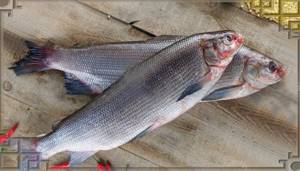
The first wave of the spawning run begins in July-August and is accompanied by a massive return of the semi-anadromous form to the mouths of their native rivers (homing) with further movement upstream to search for suitable spawning sites. A little later, preparation for procreation begins in residential populations that did not go out to feed at sea and do not require long movements along the riverbed.
To learn more:
Description of the trout fish - how is it useful?
The main factor in the start of muksun spawning is the water temperature, which must drop to +4-8°C. If the autumn is too warm, the fish that enter the rivers begin to actively feed in order to wait for favorable climatic conditions without harm to the body. As a representative of the Atlantic subfamily of salmon, the northern whitefish does not die after spawning and is capable of making 3-6 spawning migrations during its life. To increase the chances of survival of the fry, eggs are thrown in portions, with significant time pauses. Often the process drags on throughout the entire autumn-winter period. After this, the fish returns back to the sea or to deep places of permanent residence in a river or lake.
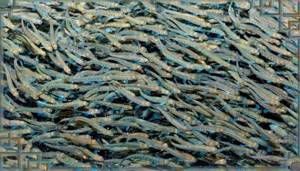
Spawning grounds are shallow flowing areas with an overgrown bottom or a coating of pebbles, small pebbles, and coarse sand. The average fertility of a large female is 25-40 thousand eggs, which are yellow in color and have a sticky top layer for quick and reliable attachment to a solid substrate. The usual duration of the incubation period is 180-200 days. The mass release of fry occurs at the end of March, April and beginning of May. The small muksun has a characteristic tiger color for camouflage and immediately hides in the coastal vegetation, where it switches to intensive feeding on zooplankton and the smallest bottom organisms. Having reached a length of 3-5 cm, it begins to slide downstream to the first standing reservoir, where the main feeding occurs.
Peled
A fairly large representative of the family - some specimens reach 5 kilograms with a body length of 55 centimeters. It is found in many reservoirs - from the Amur in the east to the Mezen River in the Arkhangelsk region.
The coloring on the back is darker than that of most whitefish species. Peled also prefer bodies of standing water, avoiding rivers with strong currents, which makes them an excellent choice for acclimatization in lakes. For example, at one time it was introduced into the Bukhtarma Reservoir in Eastern Kazakhstan, where it actively reproduces and is of considerable interest from a fishing point of view.
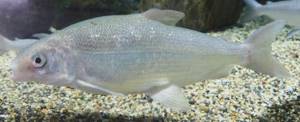
It actively feeds on crustaceans, but does not disdain plankton.
External data of the fish and its features
The body of the whitefish is covered with small scales, slightly compressed at the sides. The fish is characterized by a very small mouth, there are no teeth on the upper jaw, they quickly disappear on other parts, and are always very poorly developed. This is a rather rare fish, and some of its subspecies are listed in the Red Book. Whitefish is valued for its excellent taste.
There are many varieties of this type of fish. It is difficult to distinguish them by external signs. The similarity of all whitefish is their large flat head, silver body color and black fins. Many fish do not have spots on their bodies and fins. The female has larger scales than the male. The appearance of each subspecies may vary depending on climate, temperature, and living conditions.
Whitefish has white meat, despite the fact that the fish belongs to the salmon family (red fish). Whitefish is a fish in which only the backbone and ribs are present, due to which it is valued even more.
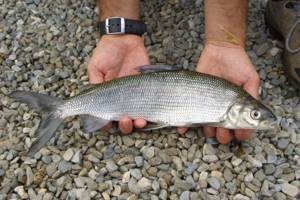
The lifespan of a whitefish can reach up to 20 years, although the catches are most often dominated by individuals aged 7-10 years. The body length, depending on the subspecies, varies from 10-15 centimeters in small individuals to 50-60 centimeters in large specimens. Regular whitefish in the catch weigh about 1 kilogram, but trophy fish can reach 12 kilograms.
vendace
European vendace is also known by other names - kilets or ripus. The smallest representatives of the whitefish family from the list given above. Usually the body length reaches 13-20 centimeters and only in the most rare cases – 35 centimeters.
At the same time, the scales are quite large - gray-blue on the back and white on the belly.
Most often found in lakes, sometimes in rivers. But it can also be found in the Baltic Sea - the Gulf of Finland and the Gulf of Bothnia. Selects places with a clean clay or sandy bottom, preferring to stay near the bottom and avoiding warm water. Distributed mainly in northern Europe: Russia, Denmark, Lithuania, Finland, Norway, Germany, Belarus and Scotland. In our country it is found in many lakes: Pleshcheyevo, Ladoga, Beloye, Chudskoye, Onega and Pskov.
The diet mainly consists of cyclops, daphnia and other crustaceans.
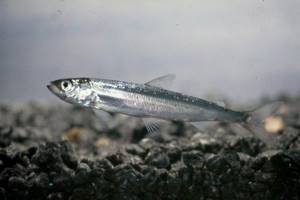
It reproduces from the second year of life, when it reaches a length of only 7 centimeters.
Migratory whitefish - Coregonus lavaretus
Coregonus lavaretus - common whitefish
Features
. The shape of the snout can be different, in some it is blunt and round, in others it is elongated. There are 33-39 gill rakers on the first gill arch, but sometimes there can be only 25. The maxillary bone reaches the anterior edge of the eye.
Coloring
. The back is blue or bluish-green, the sides of the body are silvery, the dorsal, anal and caudal fins are greenish, as are the edges of the pectoral and ventral fins.
Dimensions
. Varies depending on the area of residence. In the Baltic Sea, whitefish reach a length of 70 cm and a weight of 10 kg; in other areas, especially in lakes that are not rich in food, they grow only up to 20 cm.
Whitefish are widespread in the basins of the Baltic and North Seas, but are found in brackish waters only in the north of their range. In the British Isles, whitefish live only in mountain lakes, where they have been preserved since the Ice Age, as well as in alpine lakes.
It feeds on planktonic crustaceans, although in brackish waters it can switch to feeding on large crustaceans that live mainly at the bottom. Migratory populations enter rivers in winter to spawn. In winter, lake populations also spawn; during spawning, eggs are deposited on pebble shallows. Further development until hatching occurs within 60-70 days.
Distribution of the common whitefish
Muksun
When listing the names of whitefish, one cannot help but recall muksun. Perhaps it is he who has the widest habitat. You can meet muksun not only in our country (mainly in Siberian rivers, as well as in the lakes of Taimyr), but also in North America (Canada and the USA, where it is called whitefish). There are quite a lot of muksun in the Ob-Irtysh basin, where at one time more than one and a half thousand tons of fish were caught per year. Unfortunately, uncontrolled poaching during the spawning period sharply reduces the number of muksun.
Specimens are quite strong - up to 75 centimeters long and weighing 8 kilograms. Rarely, there have been cases when fishermen were lucky and caught individuals weighing 13 kilograms.
Tugun
Another rather small representative of the family. Its weight usually does not exceed 90 grams, and its maximum body length is only 20 centimeters. It lives in rivers flowing into the Arctic Ocean - from the Yana to the Ob. You can also catch it in the Lower Ob basin and some Ural tributaries. It has a number of local names: tugunok, manorka or Sosvinskaya herring.
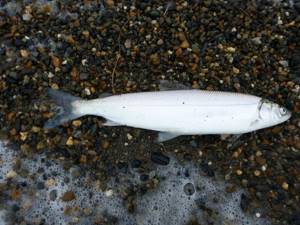
Its lifespan is quite short - about 6 years in the wild. But they develop quite quickly, going to spawn at the age of one and a half years. The main diet consists of insect larvae and small crustaceans.
Despite its small size, it is a valuable commercial fish. Unfortunately, in some reservoirs it has already been practically exterminated - for example, in many Siberian rivers. Today, catches have decreased by 10 times when compared with catches in the 80s of the last century. There are several reasons for this: river pollution with industrial waste and poaching.
Fishing for muksun
Spinning or fly fishing tackle is used. All whitefish have a small mouth, so small spoons (spinning spoons, spinners) and ultra-light silicone baits that imitate crustaceans, beetles, worms and fish are optimal. When choosing a color, it is better to give preference to bright or mixed tones.
The line should be as invisible as possible. As a standard, thin braid is used, which creates less windage in the current, together with a fast spinning reel and a microjigging rod with 2-3 grams of dough. Fly fishing for muksun requires colorful flies with hooks No. 2-4. Slow-step retrieves directed along or diagonally to the shore line work best.
To learn more:
Salmon is a red fish from the salmon family.

In winter, a float tackle with a jig “devil”, “drop”, “ant” or a special “whitefish” with two hooks on the edges is used. The bait is a large bloodworm. To attach the fish, a feeding post is used - every few minutes a pinch of chopped bloodworms, worms or maggots is thrown into the hole.
Amur whitefish
When talking about which fish are classified as whitefish, many fishermen will remember the Amur whitefish. It is not surprising - this is one of the most famous representatives of the family.
It has quite serious dimensions - up to 60 centimeters with a weight of 2 kilograms. Lives quite a long time - about 10-11 years. It spawns for the first time at the age of 5-8 years (a more specific age depends on living conditions and water temperature). Spawns in spring.
Up to three years of age, the diet of juveniles consists mainly of benthos and zooplankton. Adult fish lead a predatory lifestyle.
It lives mainly in the east of our country - in the Amur Estuary, the lower reaches of the Amur, the Tatar Strait, and also inhabits the southern part of the Sea of Okhotsk.
Baikal omul
One of the rarest representatives of the whitefish family, a photo of which is attached to the article. It is endemic, that is, found only in one place on Earth - in Lake Baikal.
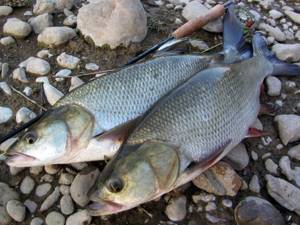
Adults reach a weight of 30-60 centimeters and weigh up to one and a half to two kilograms. But sometimes fishermen come across fish weighing 7 kilograms.
Spawning occurs in the fall - for this, the omul rises against the flow of the rivers.
The main diet of juveniles consists of benthic invertebrates and pelagic crustaceans. Adults, like most whitefishes, are predators, feeding on the young of various fish species.
For a long time it was believed that the Baikal omul is only a subspecies of the Arctic. However, recent research by geneticists has proven that they developed separately and therefore this species is independent and truly unique.
Pyzhyan
Another representative of whitefishes of great commercial importance. Found in rivers belonging to the Arctic Ocean basin - from the coast of Murmansk to the Canadian Arctic. It is divided into river and semi-anadromous forms.
The body is elongated, but over the years it becomes increasingly tall. Between the dorsal fin and the head there is a pronounced hump. The genus is small and located quite low. There are no teeth on the jaws - only the lingual plate has small and rather sparse teeth.
Quite often it reaches a body length of 55 centimeters and a weight of 2 kilograms.
With age, the silver body acquires a beautiful golden tint. In addition, during spawning, white epithelial tubercles appear on the head, fins and body - they are more pronounced in males.
Whitefish: description, types and spawning. Where is whitefish found and what does it eat?
Fishes of this group are the most difficult of all to accurately systematize, since they form vast types of races, tribes and forms. Whitefish came to us, no less, from the Ice Age, becoming, in fact, a semblance of relict organisms.
Description of whitefish
Coregonus or whitefish is a genus of the family Salmonidae (salmon). Some scientists place it in a separate whitefish family, along with nelma and whitefish.
The whitefish is distinguished by its compressed body, covered with medium-sized scales, and a medium-sized mouth that does not have teeth on the vomer and maxillary bones.
The teeth in other parts of the oral cavity are either extremely poorly developed or disappear over time.
Another distinctive feature of the whitefish is that its upper jaw bone does not extend beyond the eye. Common characteristics of whitefish also include the fact that the position of the mouth often changes - from almost terminal to typically inferior, depending on the species and shape. You can also trace the presence of a snout platform, the height of which is less than its width.
In size, whitefish are relatively small, with a standard length reaching up to half a meter (usually 40...50 cm) with an average weight of 700...800 g. However, the most powerful forms of whitefish are also found - weighing approximately 1000 g with a body length of 50...60 cm . There are also whitefish weighing from 3000 g to 5000 g.
Almost all representatives of whitefish have a light color - silver-white or silver-gray sides against a darkish back , giving off olive-brown, green or lilac tones, and a milky-light or slightly grayish belly.
The fins, on the contrary, are darker and can even be black. The intensity of this color varies slightly in each variety and form. Whitefish do not have spots on their fins or body.
This is accurately reflected in its name in English - “white fish”, which translates as “white fish”.
Types of whitefish
Despite the enormous diversity of forms, tribes and races, whitefish are usually divided into three basic species based on habitat :
- lake whitefish;
- passing whitefish;
- river whitefish.
The most common of them is river whitefish. It enters rivers from large lakes and seas to spawn. As a rule, it is somewhat longer and darker than the described varieties, with a small head and a blunt, rounded nose.
Above the lateral line it has not 10, like all other whitefish, but 11 scales.
The number of its gill rakers coincides with their number in the sandpiper, however, in this whitefish the body is even more flattened laterally and the back rises straight from the back of the head to the dorsal fin in a fairly flat arc. The ventral and pectoral fins are pointed.
The color of the back is grayish-green, with steely overtones. The sides are silvery, blue in color and have longitudinal light stripes. The iris of the eyes is silvery, grayish on top. The average weight of river whitefish is 2...4 pounds (rarely - 7).
In addition, whitefish are divided into species and according to the depth of their habitat :
- pelagic;
- coastal;
- deep-sea.
Where are whitefish found?
Whitefish is a commercial fish species, therefore it was acclimatized in the water sources of most zones of Russia and the post-Soviet space.
Very successful whitefish production is developed in the Gulf of Finland, Peipus, Onega, Ladoga and other local lakes.
It widely covers the Kola Peninsula, choosing to live there mainly the largest lakes - Seydozero, Pankunyavr, Umbozero and Lovozero.
In addition, whitefish inhabit the vast majority of water bodies located in the Arctic Ocean basin - from the White Sea and the Barents Sea to Chukotka.
It is also found in rivers such as Penzhina and Anadyr, and is no less common in the Baltic Sea basin, where it is especially widely represented in Karelian reservoirs and the Curonian Lagoon.
And in the Transbaikalia zone there is an extremely amazing whitefish, the spawning of which occurs in early spring (it is classified as a special subspecies).
- Whitefish also live in the waters of the North American continent , populating the waters of Alaska and Canada. For the most part it prefers rivers, although it is also found in seas and lakes (where it survives the winter cold). All these forms have individual differences among themselves - in fins, color, nose, etc.
- What they have in common is that whitefish choose cold and temperate countries in the northern hemisphere as their main habitat.
- For the most part, they are deep-sea inhabitants and extremely adhere to the bottom, which is why, when lifted up by nets, they sometimes become greatly inflated (due to the expansion of the swim bladder), like many deep-sea fish.
What does whitefish eat?
Basically, whitefish are predatory fish with extremely cautious habits , but in large bodies of water (such as lakes), whitefish have a different feeding pattern, given their division into pelagic, coastal and deep-sea inhabitants: they range from atypical benthophages to habitual planktivores .
Whitefish often become predatory, devouring the eggs of both their own species and other fish.
Their standard diet includes most insects (aquatic or semi-aquatic), mollusks, crustaceans, larvae, etc. However, the whitefish does not pass by the fry, juveniles, including its own species, as well as smelt and other fish.
Whitefish spawning
The beginning of spawning in whitefish occurs at 4-5 years of age in males and 5-6 years in females . In terms of timing, it usually falls in the autumn, but due to the length of the autumn period it often stretches, including the winter months. However, this is due not only to the duration of autumn and the remoteness of cold weather, but also to the zonal extent of the reservoirs in which it lives.
Thus, whitefish spawning begins in September (traditionally in the middle) and ends in November, and in some reservoirs even at the end of December–early January . It chooses shallow bodies of water as spawning sites, swimming into rivers from seas and lakes.
During feeding, adult individuals stick to shallow water - open areas of lakes and areas of coastal dumps, approximately 1.5...8 meters from the bottom level. But they can also swim to great depths - 8...20 meters. Whitefish spawning usually occurs at water temperatures from +5 to +1.5 degrees.
However, there are also cases of its omission.
The fertility of whitefish traditionally reaches 20 thousand/30 thousand eggs, and in one form of whitefish it is even about 50 thousand. It is slightly lighter in color than trout. They spawn on rocky areas near the bottom surface or on coarse sand.
Source: https://www.manorama.ru/article/Ryba_sig.html
Chir
This fish is found only in two countries in the world - Russia and Canada. In our country it is found everywhere - from Kamchatka to the European part of the country. Feels great in some bays of the Arctic Ocean with semi-fresh water. Prefers places with weak currents.
Usually weighs no more than 4 kilograms with a body length of 80 centimeters. But sometimes larger specimens are caught - up to 16 kilograms in weight.
Matures for spawning at 6-8 years. It spawns with large (about 4 millimeters in diameter) light yellow eggs. This usually happens from October to November. Life expectancy under good conditions reaches a quarter of a century. The diet includes not only mollusks, insects and crustaceans, but also juvenile fish.
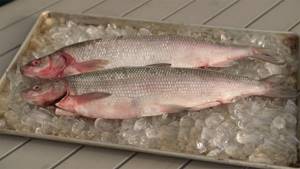
It has a wide body, slightly flattened from the sides. The body is silvery, sometimes with a golden tint. The dark back is covered with dense and large scales.
The meat is tasty, fatty, with a small number of bones, which makes the fish a commercial catch. Residents of the North use sugudai and stroganina for cooking. Also perfect for smoking - not only cold, but also hot.
Cooking whitefish
Whitefish is a popular culinary fish. It is baked, stewed, boiled, used for fish soup, sealed in jars, and the like. Meat has healthy vitamins and microelements in huge quantities. Whitefish contains:
- up to 8 grams of fat;
- about 18 grams of protein.
- Calorie content 145 kcal.
Depending on the size and habitat, the fat content of the meat changes. Therefore, it is not used in dietetics - fat content standards may be increased. Whitefish is not recommended for consumption by obese people with cholecystitis and duodenal ulcers.
Despite the fact that it belongs to the class of relatively fatty fish, the calorie content is low - about 145 kilocalories. Meat contains substances necessary for the human body. In particular, zinc, fluorine, molybdenum, as well as vitamins E, A and D.
How to cook? The recipe for oven-baked whitefish is especially popular.
How to salt whitefish? Video:
Cooking whitefish in the oven:
The dish turns out delicious, bright in taste, but at the same time tender. Required:
- Clean the fish;
- Make a cut near the fins;
- Make an incision along the length of the spine;
- Scoop out the flesh and you will get two smooth, boneless fillets;
- Mix your favorite spices, olive oil, flour and salt in a separate container;
- Dip the fillet on both sides and fry a little in a frying pan;
- Place the fish on a baking sheet, cover with a bed of vegetables and cheese (use eggplant, tomatoes, peppers - whatever products you like best).
Detailed video on cooking whitefish in the oven, full recipe:
Whitefish is a popular, affordable and very healthy fish. By adding it to your diet at least once every two weeks, you can significantly improve your immunity and replenish the lack of vitamins A and E.
